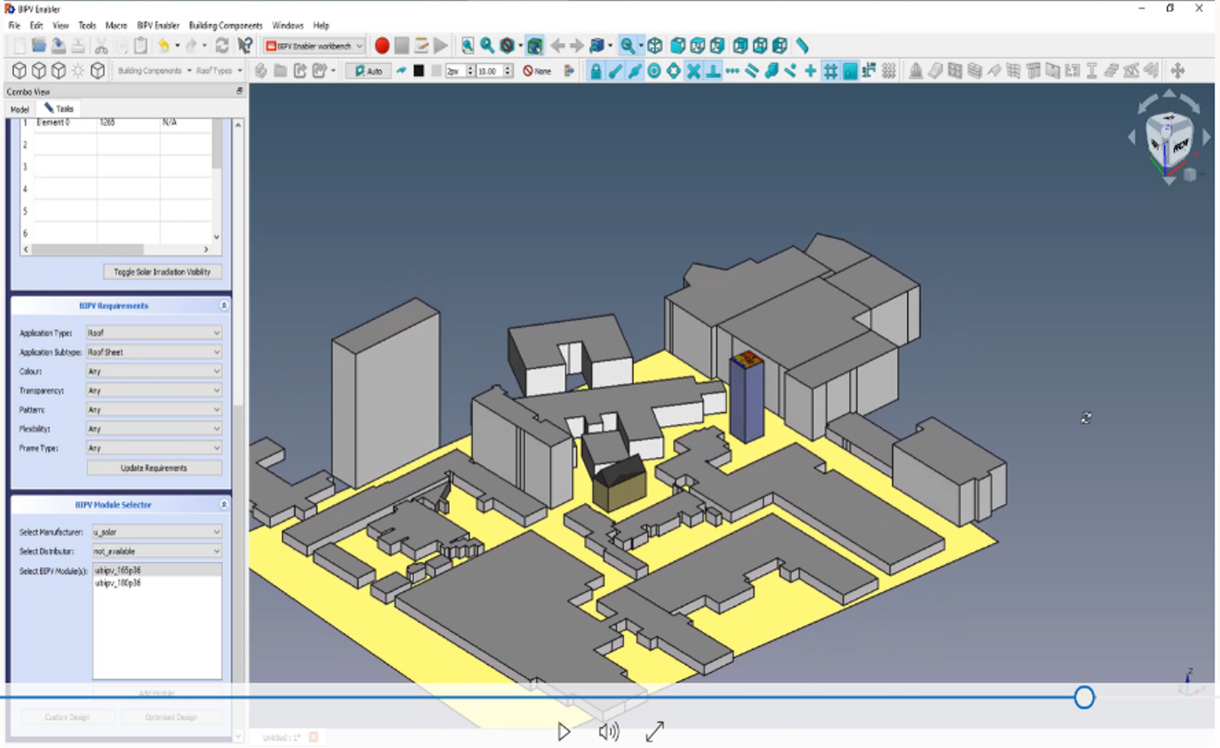What is BIPV enabler?
BIPV enabler is a user-friendly platform that integrates product, regulation, technical, economic and construction data to create the best BIPV solution. BIPV enabler consists of a BIPV product database, with standard guidelines and lightweight, user-friendly interfaces to facilitate decision making at the conceptual building design stage. Our platform will provide an optimized BIPV product which complies with construction codes, design, installation, and maintenance options and configures easy-to-use interfaces for different stakeholders. This one-stop solution delivers value as a commercialised handy tool and professional services for users such as PV manufacturers in product promotion and building professionals in BIPV design, construction, and facility management.

Features of BIPV enabler
Facilitate design of BIPV system for various building types
BIPV enabler can model many types of roof, façade, and external integrated devices BIPV applications across various building types.
Databases
Current BIPV product database
Our BIPV product database consists records of 67 BIPV modules which were collected from respective manufacturers and suppliers. The BIPV products are automatically sorted based on the application type and building type. The BIPV modules can also be organized based on parameters such as the module technology, transparency, colour, patterns frame type etc. Further, you can easily make your own products to create BIPV designs as well.
Local climate data
The Australian climate data provided in BIPV enabler are based on Bureau of meteorology of Australia. The climate data include 21 ground measuring stations. You can use the interactive map to conveniently select the climate data by selecting the location of the project.
Australian building standards
A special feature of BIPV enabler is that in BIPV module selection it will consider the requirements of Australian building standards for various building classes. The BIPV modules that matches the regulatory requirements of the selected building class are selected automatically. We have compiled a database of standards and regulations for this purpose. It consists of thermal, structural, daylighting, electrical and fire safety requirements that are applicable to BIPV to be used as part of roof and façades based on National Construction Code (NCC), associated Australian Standards for building Classes 1 to 9 and International Standards.
Another important feature of BIPV enabler is that it will calculate the wind load of the BIPV designs based on the selected BIPV modules. Guidelines stipulated in AS1170.2 : Structural design actions Wind actions are considered in the assessment process.
Building material database
Our building material database consists of data related to conventional building material that can be used as alternatives to BIPV modules. The database consists material costs and installation costs which are used under material offset in the financial analysis process.
Major steps in BIPV Enabler
Create 3D models
A 3D representation of building and surrounding buildings and objects is extremely important for determining the solar irradiation. Buildings and objects can be created quickly and easily in the BIPV 3D platform using geometrical shapes library. Using open maps, the neighbouring buildings and surround environment of the project can be extruded to facilitate the solar irradiation and shading analysis. Further, 3D models of ifc file formats can be imported to enter building data.
Optimized BIPV designs
BIPV enabler includes optimization of BIPV system design which considers BIPV system energy generation, financial analysis, and environmental analysis. Our platform can identify possible combination design parameters of BIPV design to arrive at the optimum solution(s). It can do this accurately in much less time otherwise can be a day or sometimes week-long calculation if done manually.
Visualization of solar irradiation and shading analysis
BIPV enabler can show the daily, monthly, and annual solar irradiation levels and shading for each point on the roof and vertical façade area. Based on the solar irradiation level the users can select the areas to place BIPV modules.
Detailed project results
The detailed results overview contains representations of the monthly, daily, or hourly simulation results and the results of cost-effectiveness which can be saved in word or pdf format.
Module assignment in 3D model
The roof and vertical façade areas can be selected to cover with the maximum possible number of modules automatically, or manually.
BIPV project database
We also developed a BIPV project database. There are forty-six applications integrated as continuous roof, discontinuous roof, skylights, rainscreen/cladding, curtain wall, double skin façade, balustrade and shading device and equipped with c-Si, a-Si and CIGS technology. The project specific information such as system capacity, annal energy generations, area, building energy generation, and electricity price are included. The projects can be evaluated based on multi-criteria decision-making performances.
Do you want to know more?
Contact us
Please email rebecca.yang@rmit for more information, licensing and trial versions.



